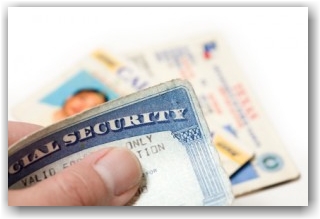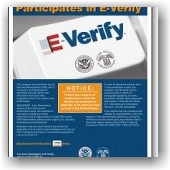Posts Tagged ‘OSC’
Friday, July 8th, 2016

This rule implements as an inflation adjustment fines for employing unauthorized workers for Form I-9 paperwork violations, and for immigration-related discrimination. These new fines increase the penalties from 35% to 96% depending on the nature and severity of the violation.
We encourage you to review your policies, procedures and your Form I-9 inventory. Remember, the key to defending any employment related investigation is to evidence that there is and has been a consistent pattern of responsible, good faith effort on the part of the employer in establishing a compliant workforce.
Refer here for the details.
Tags: DOJ, I-9 AUDIT, I-9 Compliance, I-9 Penalties, I-9/E-Verify, ICE, Immigration compliance, Legal Workforce, OSC, USCIS
Posted in DOJ, I-9/E-Verify News, ICE, OSC, USCIS | Comments Off on DOJ issues interim final rule increasing fines 35-96% for employing unauthorized workers
Wednesday, December 16th, 2015

The Department of Justice’s Office of Special Counsel (OSC) and the U.S. Immigration and Customs Enforcement (ICE) have issued a six-page joint Guidance for Employers Conducting Internal Form I-9 Audits that can be viewed here: http://www.justice.gov/crt/file/798276/download
This guidance is a result of a six-month intra-agency initiative to foster greater cooperation across government agencies in the I-9 audit space. The group overseeing this initiative, entitled the Interagency Working Group for the Consistent Enforcement of Federal Labor, Employment and Immigration Laws, is tasked with improving the effectiveness of investigations by ICE and the OSC.
For more
Tags: Department Of Homeland Security (DHS), Employer Compliance, Employment Eligibility Verification, I-9 Audits, I-9 Form, I-9/E-Verify News, ICE, Immigration compliance, Legal Workforce, OSC, Self-Audits
Posted in Uncategorized | Comments Off on OSC & ICE Publish Guidance to Employers on Internal I-9 Audits
Sunday, September 20th, 2015

Plain and simple, failing to comply with IRCA’s I-9 rules have, and are continuing at a rapid rate, to result in significant fines, loss of access to government contracts, an onslaught of negative publicity, business closure, criminal penalties and even imprisonment. Here are a few examples of recently settled cases in August 2015:
1) Creating discriminatory barriers for immigrants who have permission to work in the United States, $165 civil penalty with $50K in back pay:
http://www.justice.gov/opa/pr/justice-department-settles-discrimination-claim-against-louisiana-crane-construction
2) Requiring non-U.S. citizens, but not similarly-situated U.S. citizens, to present specific documentary proof of their immigration status to verify their employment eligibility, $200K civil penalty: http://www.justice.gov/opa/pr/justice-department-settles-immigration-related-discrimination-claim-against-nebraska-based
3) City of Eugene, OR improperly restricted law enforcement positions to U.S. citizens at the time of hire, even though no law, regulation, executive order or government contract authorized such a restriction. must pay a civil penalty, train its employees about the anti-discrimination provision of the INA and be subject to monitoring by the Justice Department for a period of three years!
http://www.justice.gov/opa/pr/justice-department-settles-citizenship-discrimination-claim-against-city-eugene-oregon
:::::::::::::::::::::
Immigration Compliance Group provides US inbound immigration services to individuals and employers throughout the USA and abroad. We specialize in business immigration and have a depth of experience in the IT, healthcare, arts, entertainment and sports industries, amongst others. Our services include complex business visas for investors, multinational managers, skilled professionals, outstanding individuals of high achievement (O-1, P visas, EB-1 and EB-2 Exceptional Ability cases) and PERM Labor Certification. We additionally provide employer compliance consulting services on proper I-9 (Employment Eligibility Verification) management, auditing, training, and work with our clients to develop a culture of immigration compliance. Our door is open for new clients — we extend a 20% discount on the first case with our firm. Contact us at info@immigationcompliancegroup.com or call 562 612.3996.
Tags: DOJ, Employer Compliance, Employoment Eligibility Verification, I-9 Audits, I-9 Form, I-9 Penalties, I-9/E-Verify News, ICE, Immigration News, Legal Workforce, OSC, Social Security Card, USCIS
Posted in DOJ, Employer Compliance, I-9/E-Verify News, ICE, Immigration News, OSC | Comments Off on Recent DOJ Worksite Enforcement Settlements that Shed Light on Form I-9 Employer Compliance
Friday, July 17th, 2015

USCIS released details of proposed new changes to the E-Verify program on June 8, 2015 that were published this week. The notice, found here, proposes several changes to E-Verify and seeks public comments until August 7, 2015 and links to new Q&A. These changes will affect all employer users, including Federal Acquisition Regulation (FAR) contractors.
The three critical changes entail:
1) Requirement that employers re-verify the continuing work authorization of employees within three “Employer” days of the expiration of the employee’s “last” grant of work authorization.
a) This requirement tracks the current continuing duty of employers to re-verify expiring work authorization of employees in Section 3 of the I-9 form or, in the alternative, to complete a new I-9.
b) This differs from the I-9 process in that the E-Verify time frame for re-verification of the employment authorization is three days after its expiration, whereby the I-9 regulations state that an employer re-verify the expiring work authorization of an employee on or before the day it expires. In E-Verify, the proposed process cannot be started until after the expiration of the employment authorization.
c) The re-verification requirement extends to employees hired before an employer began participating in the E-Verify program. Thus, the proposed change would require that employers re-verify an employee’s expiring work authorization regardless of whether they have previously created an E-Verify case for that employee or not. This again differs from the current E-Verify program rules that explicitly prohibit an employer verifying the work authorization of employees hired before the employer began participating in the program (with the exception of FAR E-Verify employers).
2) Requirement that employers print the re-verification confirmation page and retain it along with an employee’s I-9 records or record the E-Verify re-verification case number on the employee’s I-9 Form.
3) Provides a process for employees to seek review of E-Verify Final-Nonconfirmations.
::::::::
Immigration Compliance Group provides US inbound visa services to individuals and employers throughout the USA and abroad. We specialize in business immigration and have a depth of experience in the IT, healthcare, arts, entertainment and sports industries, amongst others. Our services include complex business visas for investors, multinational managers, skilled professionals, outstanding individuals of high achievement and PERM Labor Certification. We additionally provide employer compliance consulting services on proper I-9 (Employment Eligibility Verification) management, auditing, training, and work with our clients to develop a culture of immigration compliance.
Tags: Agriculture, E-Verify, Employer Compliance, FAR E-Verify, Federal Contractors, I-9 Compliance, I-9 Form, I-9/E-Verify News, ICE, Immigration News, Legal Workforce, OSC, Seasonal Workers, USCIS
Posted in Agriculture, Employer Compliance, Federal Contractors, I-9/E-Verify News, ICE, Immigration News, OSC, USCIS | Comments Off on E-Verify Announces Major Proposed Changes
Saturday, June 20th, 2015
 Since early 2015, qualified California residents have been able to apply for and receive a driver’s license issued by the Department of Motor Vehicles without proving that their presence in the United States is authorized under federal law. All employers must accept the AB 60 driver’s license as a Form I-9 List B Identity document if the license reasonably appears to be genuine and to relate to the individual. As with all permissible List B driver’s licenses, the AB 60 driver’s license must contain either a photograph or list the individual’s name, date of birth, gender, height, eye color, and address. The AB 60 driver’s license only documents the employee’s identity; California employers must still examine a List C document that establishes employment authorization, such as a Social Security card or birth certificate.
Since early 2015, qualified California residents have been able to apply for and receive a driver’s license issued by the Department of Motor Vehicles without proving that their presence in the United States is authorized under federal law. All employers must accept the AB 60 driver’s license as a Form I-9 List B Identity document if the license reasonably appears to be genuine and to relate to the individual. As with all permissible List B driver’s licenses, the AB 60 driver’s license must contain either a photograph or list the individual’s name, date of birth, gender, height, eye color, and address. The AB 60 driver’s license only documents the employee’s identity; California employers must still examine a List C document that establishes employment authorization, such as a Social Security card or birth certificate.
View the Example of the AB-CA Driver’s License annotated with “Federal Benefits Apply”.
Tags: CA AB-60 Driver's License, DACA, Department Of Homeland Security (DHS), Employer Compliance, EMPLOYMENT ELIGIBILITY, I-9 Form, I-9/E-Verify News, ICE, Immigration News, Legal Workforce, OSC, Social Security, USCIS
Posted in DACA | DAPA, Employer Compliance, I-9/E-Verify News, ICE, Immigration Legislation, Immigration News, OSC, Social Security, USCIS | Comments Off on California New AB 60 Driver’s License: Is it Good for Employment Eligibility?
Tuesday, October 7th, 2014

IMPORTANT INFORMATION
As of January 1, 2015, E-Verify will begin disposing of E-Verify records that are over 10 years old. In order to retain case information, E-Verify employers may download and save the new “Historic Records Report.” If you want a record of your cases that are more than 10 years old, you must download the new Historic Records Report before December 31, 2014. The report will include all transaction records for cases more than 10 years old. The report is only available until December 31, 2014.
NOTE – this Report will ONLY BE AVAILABLE from October 1, through December 31, 2014. The Fact Sheet provides more information as to how to proceed to download applicable E-Verify records.
If you were not using E-Verify on or before December 31, 2004, you do not need to download the report. There will be no records to report. Note that E-Verify will continue this practice on an annual basis.
:::::::::::::::::::::::::::::::::::::::::::::
USCIS Now Offering I-9 Webinars On-Demand
On September 25, 2014, USCIS published the first Form I-9 Webinar On – Demand. Now you can watch the free Form I-9 webinar at any time.
Choose the chapters of your choice or watch the entire 22 minute video in one sitting. You will see how to complete Sections 1, 2 and 3, best practices
and much more. It’s a great training tool. Visit I-9 Central to learn more and view other videos in the multi-media section.
 Form I-9 Webinar on Demand | USCIS uscis.gov
Form I-9 Webinar on Demand | USCIS uscis.gov
Tags: E-Verify, E-Verify Records Retention, Employer Compliance Policy, form I-9, I-9 On-Demand Webinars, I-9/E-Verify News, ICE, Immigration News, OSC, USCIS
Posted in Employer Compliance, I-9/E-Verify News, ICE, Immigration News, OSC, USCIS | Comments Off on E-Verify Records Retention and Disposal | I-9 Webinars On-Demand
Sunday, January 5th, 2014
 DHS/ICE continues to issue Notices of Intent to Fine (NOFs) at an unprecedented rate for Form I-9 related infractions. Mistakes occur in the I-9 process, it’s inevitable. While establishing a written compliance policy, training and careful prevention is the best approach. All employers should take time at the beginning of each year to conduct an internal audit and self-examination of their systems, operating procedures, and past and present practices for handling I-9s, as well as to access training needs for the employees charged with handling and supervising the I-9 process. We also recommend that you review your E-Verify submissions, as well as revisiting just how compliant your I-9 software really is with your vendor if you are using an electronic system.
DHS/ICE continues to issue Notices of Intent to Fine (NOFs) at an unprecedented rate for Form I-9 related infractions. Mistakes occur in the I-9 process, it’s inevitable. While establishing a written compliance policy, training and careful prevention is the best approach. All employers should take time at the beginning of each year to conduct an internal audit and self-examination of their systems, operating procedures, and past and present practices for handling I-9s, as well as to access training needs for the employees charged with handling and supervising the I-9 process. We also recommend that you review your E-Verify submissions, as well as revisiting just how compliant your I-9 software really is with your vendor if you are using an electronic system.
While there are many checklists and do-it-yourself guides and webinars available on the Internet and elsewhere, consulting a licensed attorney or specialist in the field who is familiar with I-9 and E-Verify compliance issues can save employers hours of research, provide a solution tailored to your organization, and save you thousands of dollars in fines and penalties should ICE knock on your door.
When ICE notifies an employer of their intention to perform an audit, it opens the door for an onslaught of inquiries and investigation from other government agencies that range from SSA mis-match issues to Department of Labor (DOL) wage and hour, USCIS, IRS, and more if you have areas of incompliance in your operating procedures. This is not the time during an audit when under pressure to clean up compliance problems.
New employers are often more at risk because many are not even aware of the I-9 requirement, and probably are also unaware of the need for all employees to complete the I-9 Form. Some are aware, but they lack knowledge concerning the regulations that govern the form; such as, timeframes, acceptable documents, form retention, and other important details that are integral to the process. Particularly, there are problems with industries such as IT consulting, healthcare, staffing agencies, and other organizations with multiple locations in regard to completing the I-9-Form remotely with the employer’s designated agent and employee in different locations.
These are just a few reasons why we urge you to assess the strengths and weaknesses of your present compliance program, and start the New Year fresh with a renewed commitment to implement best practices that will provide the foundation upon which you can develop and maintain a more compliant business and workforce.
You might be interested in joining our LinkedIn group, I-9/E-Verify: Smart Solutions for Employers,” and signing up to receive via RSS feed or email our Blog posts.
Tags: +, Department Of Homeland Security (DHS), DOL, E-Verify, I-9 AUDIT, I-9 Best Practices, I-9 Comipliance, I-9 Form, I-9 Training, I-9/E-Verify News, ICE, Immigration News, Legal Workforce, OSC, SSA
Posted in Department Of Homeland Security (DHS), Department Of Labor (DOL), Employer Compliance, Healthcare, I-9/E-Verify News, ICE, Immigration News, OSC, Social Security, Staffing Agencies, USCIS | Comments Off on Compliance Audits are Recommended for Employers at the Beginning of the New Year
Monday, November 11th, 2013

While DHS/ICE continues to issue Notices of Intent to Fine (NOFs) at an unprecedented rate for Form I-9 related infractions, this is yet another reminder that you can choose to pay the fine or you can contest the fine and file for a hearing (within 30 days of receipt of the NOF) before an Administrative Law Judge (ALJ) who handles cases related to employer sanctions, document fraud and unfair immigration-related employment practices. OCAHO has more than proven that they are willing to reassess and lower fees in just about every case in recent months.
Note that many employer sanctions cases never proceed to the hearing stage because either the parties reach a settlement with the approval of the ALJ, or the ALJ resolves a case through a prehearing ruling.
We recommend that your first step in the process be to retain experienced representation that specializes in the practice area of employer compliance to guide you step by step through the process – don’t attempt to go this alone. The next step is to understand the process that has been summarized very efficiently in the recent Fact Sheet that we refer to here
Should you have any questions or wish to become a client of our office, please contact us or refer to our services & solutions page.
Tags: ALJ I-9 Hearing, Department Of Homeland Security (DHS), Document Fraud, DOL, Employer Sanctions, I-9 Fees, I-9 Form, I-9/E-Verify News, ICE Audit, ICE Investigation, Immigration News, IRCA, Legal Workforce, Notice of Intent to Fine, OCAHO, OSC, SSA
Posted in DOJ, Employer Compliance, Federal Contractors, I-9/E-Verify News, ICE, Immigration News, OSC, Social Security | Comments Off on How to Contest an I-9 Notice of Intent to Fine (NOF)
Thursday, October 24th, 2013
 We have written many articles over the years on what happens when ICE serves an employer with a Notice of Inspection (NOI); see below for links to our articles and resources. Today, ICE released a new Fact Sheet that referrences the IRCA law in the 1st paragraph, and then summarizes the order in which an ICE administrative inspection proceeds, the types of notices that are issued following an I-9 ICE audit, how fines are determined based upon knowingly hiring and continuing to employ violations, to substantive and uncorrected techical violations, and how these fines and penalties are calculated.
We have written many articles over the years on what happens when ICE serves an employer with a Notice of Inspection (NOI); see below for links to our articles and resources. Today, ICE released a new Fact Sheet that referrences the IRCA law in the 1st paragraph, and then summarizes the order in which an ICE administrative inspection proceeds, the types of notices that are issued following an I-9 ICE audit, how fines are determined based upon knowingly hiring and continuing to employ violations, to substantive and uncorrected techical violations, and how these fines and penalties are calculated.
The penalties for ignoring the legal requirements of the I-9 process can be quite severe, even in cases of unintentional omissions and uncorrected I-9 mistakes. Civil penalties for such errors may range from $110 to $1,100 for each effected employee. A business with thousands of employees and multiple worksites may face a significant financial burden in noncompliance penalties. The fines may be further increased if ICE determines that an employer knowingly hired unauthorized foreign nationals, and can range from $375 to $16,000 per violation with repeat offenders on the high end. Employers and their representatives convicted of having engaged in a pattern or practice of knowingly hiring unauthorized foreign nationals, may also face criminal charges and fines of up to $3,000 per employee and/or six months’ imprisonment. Other federal criminal statues may provide higher penalties in certain fraud cases.
Employers and individuals who commit citizenship status or national origin discrimination may be ordered to pay civil fines and attorneys’ fees. The penalties range from $375 to $3,200 for the first offense for each individual discriminated against; from $3,200 to $6,500 for the second offense; and for subsequent offenses, not less than $4,300 and not more than $16,000 for each person effected.
The trend toward increased scrutiny of immigration employment practices will likely continue in the foreseeable future. With immigration reform still uncertain, ICE continues to step up enforcement activities with a deluge of NOI’s to employers every few months. These recent developments have made it even more critical that employers maintain a strong immigration compliance profile. Employers can no longer afford to think that because they don’t hire foreign nationals, they don’t have any I-9 issues or need to comply with I-9 immigration regulations.
The key to I-9 compliance for most organizations starts with a thorough self-examination of existing paper I-9’s, E-Verify submissions (if applicable), standard operating procedures, and past practices. While there are many checklists and do-it-yourself guides, free webinars and Podcasts available on the Internet and elsewhere, consulting an experienced immigration consultant or attorney in the practice area can save employers hours of research, provide a solution tailored to your organization and save you thousands of dollars in fines and penalties.
You should strongly consider an independent I-9 audit if…
- You’ve had a turnover in the HR position(s) charged with the responsibility of handling and processing I-9 Forms
- None of the staff charged with the I-9 process has been formally trained
- You already know that you have I-9 document violations, errors and unintentional mistakes
- You have recently gone through a corporate reorganization, merger or acquisition
- You know you have an on-boarding process that is complex, such as multiple jobsite locations where the I-9 process takes place
- When you haven’t documented your I-9 Form policies and procedures in a policy statement or procedures manual
- If you have a large volume of foreign worker I-9 forms
- If you do not have a calendar system for re-verification or terminated employee retention
- If you do not have a centralized I-9 recordkeeping process
- If you are photocopying documents presented during the I-9 process for some and not for others
- You participate in government contracts and have been asked to perform an I-9 audit
- You have not performed a random or full audit within the last year by either an internal individual who is familiar with I-9 compliance rules but does not deal with I-9s on a regular basis, or by a reputable independent I-9 auditor.
- You’ve never performed a self-audit or had any outside provider perform an I-9 audit
- You do not know how to make corrections to the I-9 form
- You’ve received SSA No Match Letters
- Your industry is being targeted by ICE
- You’re unaware that a new I-9 form was released and do not have a process in place for staying current with regulations and procedures
Immigration Compliance Group regularly represents clients from all industries to develop effective I-9 policies and compliance programs. By establishing and maintaining effective corporate policies and procedures, many of the above-mentioned warning signs can be addressed proactively in an audit before the government does one for you.
New ICE Fact Sheet
I-9Audit.com – Our Employer Resource Center Articles
Tags: Department Of Homeland Security (DHS), I-9 AUDIT, I-9 Compliance, I-9 News, I-9 Training, I-9/E-Verify, I-9/E-Verify News, ICE, ICE Audit, ICE Fines, ICE Inspection Fact Sheet, ICE Penalties, Immigration News, Legal Workforce, NOI, Notice of Inspection, OSC, SSA
Posted in Department Of Homeland Security (DHS), Employer Compliance, Federal Contractors, I-9/E-Verify News, ICE, Immigration News, OSC, Social Security | Comments Off on ICE Releases New Fact Sheet on the I-9 Inspection Process
Thursday, October 17th, 2013
E-Verify has resumed operations following the federal government shutdown. All E-Verify features and services are now available.
The following information addresses questions on how the federal government’s shutdown affected E-Verify and Form I-9.
Information For Employers
Form I-9
The Form I-9 requirements were not affected during the federal government shutdown. All employers must complete and retain a Form I-9 for every person hired to work for pay in the United States during the shutdown.
E-Verify
Employees who received a Tentative Nonconfirmation (TNC)
If an employee had a TNC referred between September 17, 2013 and September 30, 2013 and was not able to resolve the TNC due to the federal government shutdown, add 12 federal business days to the date printed on the ‘Referral Letter’ or ‘Referral Date Confirmation.’ Employees have until this new date to contact the Social Security Administration (SSA) or the Department of Homeland Security (DHS) to resolve their cases. If you have an employee who decided to contest his or her TNC while E-Verify was unavailable, you should now initiate the referral process in E-Verify. Employers may not take any adverse action against an employee because of a TNC.
Employees who received a SSA Final Nonconfirmation (FNC) or DHS No Show result
If an employee received a Final Nonconfirmation (FNC) or No Show because of the federal government shutdown, please close the case and select “The employee continues to work for the employer after receiving a Final Nonconfirmation result,” or “The employee continues to work for the employer after receiving a No Show result.” The employer must then enter a new case in E-Verify for that employee. These steps are necessary to ensure the employee is afforded the opportunity to timely contest and resolve the Tentative Nonconfirmation (TNC) that led to the FNC result.
Creating Cases: Three-Day Rule
You must create an E-Verify case for each employee hired during or otherwise affected by the shutdown by November 5, 2013. If you are prompted to provide a reason why the case is late (i.e., does not conform to the three-day rule), select ‘Other’ from the drop-down list of reasons and enter ‘federal government shutdown’ in the field. Federal Contractor
Deadlines
During the federal government shutdown, federal contractors could not enroll or use E-Verify as required by the federal contractor rule. If your organization missed a deadline because E-Verify was unavailable or if it has an upcoming deadline for complying with the federal contractor rule, please follow the instructions above and notify your contracting officer of these instructions.
Information For Employees
If the federal government shutdown prevented you from contesting a Tentative Nonconfirmation (TNC), you will be allowed additional time to contact the Social Security Administration (SSA) or Department of Homeland Security (DHS). If your TNC was referred between September 17, 2013 and September 30, 2013, and you were not able to resolve the mismatch due to the federal government shutdown, you should:
- Add 12 federal business days to the date printed on the ‘Referral Letter’ or ‘Referral Date Confirmation’ that your employer provided you after you contested the TNC. Federal business days are Monday through Friday and do not include federal holidays.
- Contact SSA or DHS by the new date to resolve your TNC.
If you received a Final Non-Confirmation (FNC) because you could not contact DHS or SSA during the federal government shutdown, or because you could not contact DHS or SSA in the first ten days after the government reopened, please contact your employer and request that the employer re-enter your query. For more information about contesting your TNC or FNC, please refer to Employee section of the E-Verify website.
Customer Support
E-Verify Customer Support expects an increase in requests for assistance. Due to this increase, customers may experience longer than normal delays and response times. We apologize for any inconvenience and appreciate your patience. For any questions or additional information about how the federal shutdown affects E-Verify, please email E-Verify@dhs.gov. For questions about Form I-9, please visit I-9 Central or email I-9Central@dhs.gov. Employers and employees may also contact E-Verify at 888-464-4218. Customer Support representatives are available Monday through Friday 8:00 am to 5:00 pm local time.
If you would like to become a client of our office or have any questions psertaining to this blog post, please give us a call.
Tags: DOL, E-Verify, E-Verify after Shutdown, Employment Eligiblity Verification, FNC, I-9, I-9/E-Verify News, Legal Workforce, OSC, SSA, TNC, USCIS
Posted in Employer Compliance, I-9/E-Verify News, ICE, Immigration News, OSC, Social Security, USCIS | Comments Off on E-Verify Now Open and Provides Instructions on Shutdown Issues for New Hires, TNCs and FNCs








